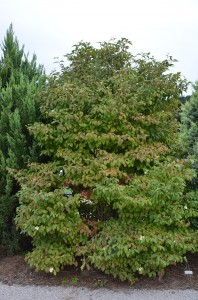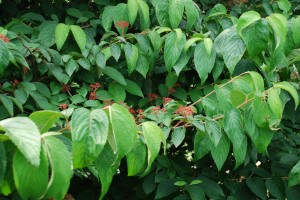Autumn may be coming or has arrived, but spring-flowering ‘Summer Snowflake’, a selection of doublefile viburnum (Viburnum plicatum var. tomentosum) continues to bloom. Native to Japan, doublefile viburnums are in a league of their own. Summer Snowflake grows 15 to 18 feet tall and a narrow 6 to 9 feet width or roughly 2:1 height to width.
Floral clusters of layered white flowers rest on the horizontal branches. Days later, prominently veined green leaves begin to emerge. Blooming is showiest, at its best around the end of April (in east Tennessee), nearly a week after flowering dogwoods (Cornus florida) have finished. Single snowy white flowers measure the size of a quarter, and each flat cyme averages 4 inches across.
Summer Snowflake is uniquely different because its branching tends to be upright and its repeat blooming. The spring bloom cycle is very showy. Secondary flowering extends almost 3 seasons. Bright red berries follow in late summer and fall, and rusty red fall color completes the season. Leaves are prominently veined. Birds quickly devour the small crop of berries.
Summer Snowflake viburnum is at its best in full sun and in a rich loamy well-drained soil. It fares well in partial sun (4 hours minimum sunlight). Shrub exhibits good drought tolerance within 2 years after planting, but repeat blooming declines if summer is exceptionally dry. Disease and insect problems are generally minimal unless shrub becomes environmentally stressed.
Summer Snowflake may be grown as a large specimen shrub or group several together for an informal hedge or screen. It rarely needs pruning except to control shrub size and form.



 Posted in
Posted in 
